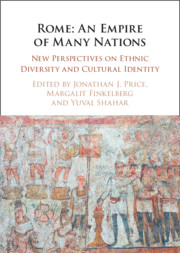Book contents
- Rome: An Empire of Many Nations
- Reviews
- Rome: An Empire of Many Nations
- Copyright page
- Contents
- Figures
- Contributors
- Acknowledgments
- Abbreviations
- Introduction
- Part I Ethnicity and Identity in the Roman Empire
- Part II Culture and Identity in the Roman Empire
- Part III Ethnicity and Identity in the Roman Empire
- Part IV Iudaea/Palaestina
- 16 The Roman Legionary Base in Legio-Kefar ‘Othnay – The Evidence from the Small Finds
- 17 The Camp of the Legion X Fretensis and the Starting Point of Aelia Capitolina
- Bibliography
- General Index
- Index Locorum
16 - The Roman Legionary Base in Legio-Kefar ‘Othnay – The Evidence from the Small Finds
from Part IV - Iudaea/Palaestina
- Rome: An Empire of Many Nations
- Reviews
- Rome: An Empire of Many Nations
- Copyright page
- Contents
- Figures
- Contributors
- Acknowledgments
- Abbreviations
- Introduction
- Part I Ethnicity and Identity in the Roman Empire
- Part II Culture and Identity in the Roman Empire
- Part III Ethnicity and Identity in the Roman Empire
- Part IV Iudaea/Palaestina
- 16 The Roman Legionary Base in Legio-Kefar ‘Othnay – The Evidence from the Small Finds
- 17 The Camp of the Legion X Fretensis and the Starting Point of Aelia Capitolina
- Bibliography
- General Index
- Index Locorum
Summary
Historical sources, and epigraphical and archeological finds attest to the presence of the Roman military presence and the establishment of the Roman base at Legio-Kefar ‘Othnay, first by soldiers of the Legio II Traiana, and slightly thereafter by the Legio VI Ferrata. An archaeological survey in the Legio area proposed the precise location of the Roman legionary base. A geophysical survey and excavation seasons allow us to assess that its size resembles Roman legionary bases in other parts of the empire during the second–third centuries CE. In this chapter we discuss the small finds from the site such as roof tiles/bricks with Roman military stamps, coins with countermarks and Roman weapons and assess their contribution to the understanding of Roman military presence by the II Traiana and the VI Ferrata legions at the site from the second to the beginning of the fourth century CE, at the latest.
Keywords
- Type
- Chapter
- Information
- Rome: An Empire of Many NationsNew Perspectives on Ethnic Diversity and Cultural Identity, pp. 275 - 299Publisher: Cambridge University PressPrint publication year: 2021
- 11
- Cited by

